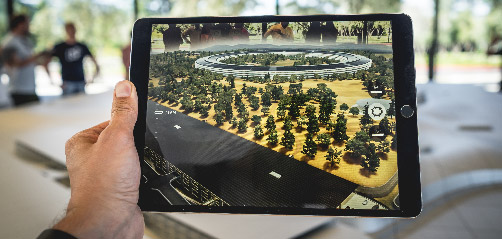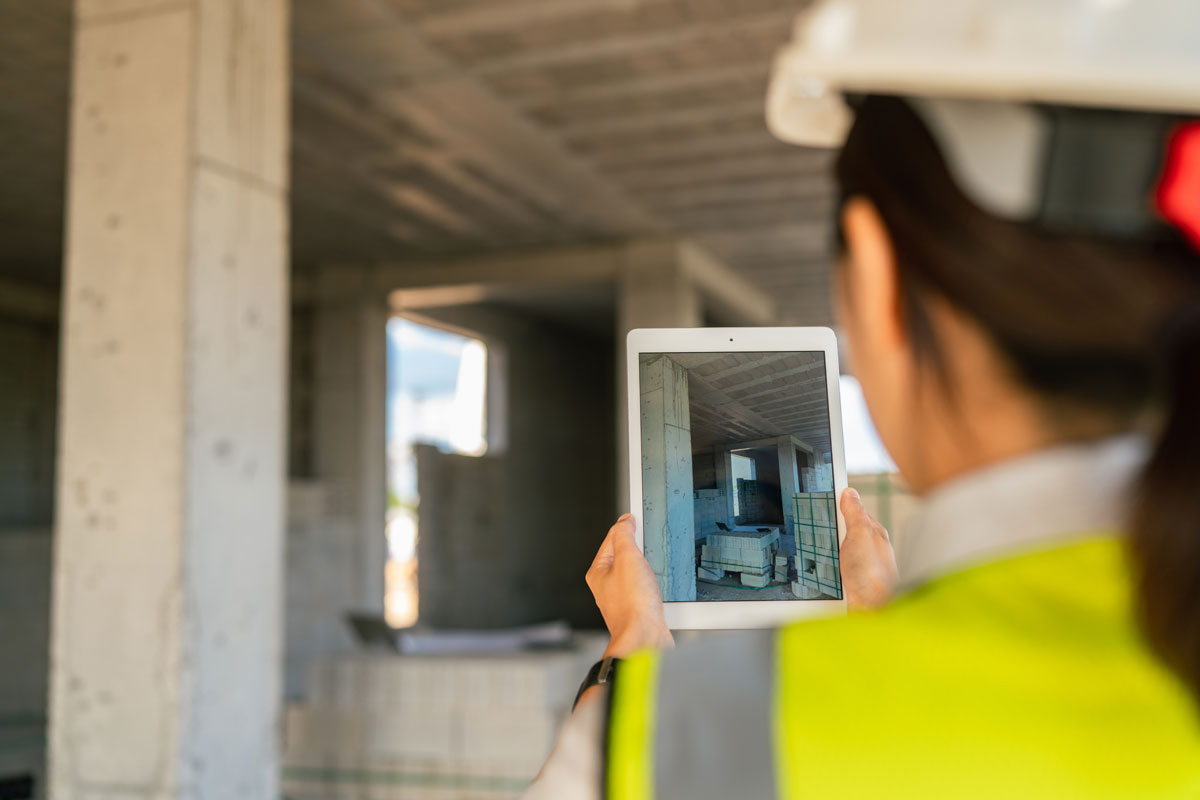The Nitty Gritty
- Learn how integrating Augmented Reality (AR) into your field service business can help expert collaboration, guided 3D work instructions, enhanced training and improved safety.
- Through AR, field service staff can access the knowledge of an expert without having to be physically present, enabling remote repairs and collaboration with colleagues.
- AR can help reduce travel costs by eliminating the need to send people to job sites for non-essential tasks, as well as enable accurate measurements and projections of sites to streamline the design process.
- Discover how AR can help business owners turbocharge service efficiency, with increased first-time fix rates and faster resolution times, as well as enable preventative maintenance.

Augmented reality (AR) has swept the world by storm, with live filters and emojis on social media, creatures from popular video games appearing as if they're in your living room, and more. The AR & VR industry is projected to reach nearly $60 billion by 2028.
But AR also has many incredible uses beyond entertainment and is quickly becoming integral to many industries, including field service and construction.\n\nBut before we can really dive into why AR is so important and all the benefits it can provide, you have to first understand what AR is. So read on for what it is, why it's grabbing and holding the attention of field service and construction businesses, and how you can use it to level up yours.
What is Augmented Reality (AR)?
Augmented reality (AR) is a technology that shows you digital objects as if they are part of your real-world environment. Here's an example: if you're looking at a site under construction and only the scaffolding is in place, an AR tool could show you the proposed finished building on top of that scaffolding. It uses a digital copy and, through your phone/tablet or special AR glasses, places that copy right in your field of view in the real world.
It's important to note that AR isn't the same thing as virtual reality (VR), where you put on a headset and it closes off anything you can see in the real world, fully immersing you in a digital environment. Instead, AR mixes digital and real-world elements to ahem, augment your reality. One of the key differences between VR and AR is that you can interact with and "touch" elements (at least digitally) in VR, but not in AR.
That said, some applications mix AR and VR, called mixed reality (MR). Essentially, it takes the interaction from VR and makes it work in an AR environment.

What is AR in Field Service?
AR in field service has a number of forms: education and training, enabling remote expert service and maintenance, assisting with construction project management and much more. But before we dive into the specifics, it's important to understand the three main types of AR: marker-based, markerless and location-based.
Marker-based AR needs points of interest or landmarks before it can provide you with your digital objects. For example, if you were repairing an air conditioner with a radio frequency identification (RFID) chip to enable AR repair, that would be a marker-based AR.
Markerless AR is used based on what the program you're using to enable AR "sees" in its vision without needing a specific reference point. This is helpful for more arbitrary uses, such as looking at a field and using AR to determine where to place survey equipment.
Location-based AR is similar to marker-based AR but uses GPS coordinates to determine what to show. Our example earlier with the projected building on scaffolding could potentially use location-based AR.
These three types of AR open a world of possibilities for augmented reality in field service (don't worry, we'll dive into specifics in a later section) and create new ways for your business to be more efficient and productive, reduce risk, and increase collaboration.
Advantages of Integrating Augmented Reality in the Field Service
Adding AR to your field service management practices has a ton of benefits for both your field service technicians and your overall business.
Expert collaboration
As we talked about earlier, AR augments your view of reality. This means you can show schematics and projections (like our building example) on top of whatever your staff are looking at. It also allows your whole team to see the same view, no matter where they are.
While we're not yet at the everyone-in-the-room-is-a-hologram cliché from many of the recent superhero movies, AR can help share notes, pictures and videos in a much more seamless way during meetings. With AR, everyone in the meeting could look at the same digital model of a job site and virtually "tour" it.
So rather than get everyone on-site to review blueprints, resolve design issues or even just check a project's status, AR can virtually bring everyone together and improve collaboration among teams–saving time and money.
Guided 3D work instructions
Your field service staff can't be masters at every type of system out there. Your construction workers can't understand the intricacies of every part of building something. People simply don't have enough "brain space" to fit all that knowledge in. It's unfortunate, but, well, there it is.
AR in field service can help. For instance, let's say you have staff on a maintenance job, but it's not a model they're super familiar with. AR can show them how to repair or maintain that system while talking to an expert, lending them all the skills they need to complete the job.
This helps optimize your business in ways never before possible. Not only do you mitigate the risk of sending a less-experienced technician, but they also get incredibly valuable on-the-job training, and you increase your first-time fix rate. For simpler jobs, AR opens the door to having staff walk customers through the repair, eliminating the need to send anyone physically there at all.
Enhanced training
Just as flight simulators revolutionized pilot training, AR and VR will transform field services, especially with training technicians. But it's more than our earlier example of sending somebody and having them talk to an expert while repairing something. AR, VR and even MR can enable staff to learn in a simulated environment, drastically improving safety. They can see simulated hazards firsthand and learn to avoid them, eliminating the danger completely from training and reducing the chance of injury from those hazards on the job.
Your business then reaps the rewards, from shorter resolution times and increased first-time fix rates to fewer trips and truck deployments. Field technicians learn the best practices with the augmented training materials and get real-world, hands-on experience. And, for those members of your staff that learn most effectively by doing, this might be a faster training approach than reading a manual or watching a video.

Leveraging AR for Field Service Efficiency
In addition to the added advantages that augmented reality brings to personnel training and cooperation, it can also have a much wider-reaching influence and revolutionize the field service industry.
Improving safety
Concern over worker safety in the construction and field service industries is huge. Especially because the rates of injury and death within the industry are some of the highest. It's estimated that over their career, 3 in 4 construction workers will have a disabling injury. Each injury (regardless of its severity) costs an average of $35,000 in direct costs, such as medical expenses and workers’ compensation.
But, the indirect costs of workplace industries are even higher. Time losses, project delays, decreased reputation, and more all affect current and future business. While you may already have strict safety measures and training programs, the fact still remains that the construction and field service industries can be dangerous.
AR has the potential to change that. Your staff could get notifications of on-site hazards before they're affected. Or alerted of issues with machines before or while your employees use them. AR can even eliminate the need for someone to be in a dangerous situation entirely. With AR, construction sites and field service could be far safer, saving both lives and business costs.
Redefining mobility: reducing travel and truck deployments
Travel and all its costs, from time to automotive and maintenance costs, is a particular part of field service and construction that has the most opportunity with AR. Your business will reduce the need to travel to job sites to only the most essential workers. Or, enable remote repairs — either by staff or by instructing customers — while still using the wealth of knowledge your expert technicians have.
Instead of physically meeting to discuss a project, site managers, engineers and designers could collaborate virtually. AR enables accurate measurements and projections of sites to streamline the design process. It’s also a lot easier to see the effects of design decisions in a more concrete and visual way with AR.
Turbocharging service efficiency
With the increased collaboration available from AR, the efficiency of your maintenance and service visits will go through the roof. From an increased first-time fix rate to faster resolution times and even enabling preventative maintenance, AR can help your staff do more in less time. This not only increases customer satisfaction, but it also lets you bring on more customers, increasing revenue with your existing resources.
Minimizing downtime and SLA compliance
With all the benefits of augmented reality in construction and field service at your disposal, your business could drastically reduce system downtime. With that, you could start offering higher service-level agreements (SLA), potentially beating your competition, landing more jobs or even commanding a higher service rate.
How Augmented Reality is Changing the Field Service Business: Challenges
Unfortunately, augmented reality in the construction industry or other field service is not without its challenges. The tech is still relatively new, and some of the hardware can be expensive. While that's eased a bit by using AR apps on your workers' existing smart devices, AR-enabled content libraries aren't the most common. You'll probably have to create most of the instructions and videos yourself. Using AR also comes with a slight learning curve, so you'll only be able to make the most of it after properly training your staff.
That said, AR field service is gaining traction. Hardware is reducing in price. More manufacturers are getting on board and creating AR-enabled instruction manuals. Before long, using AR to improve field service and construction will be a necessary technology for your business to keep up.
How to implement AR in the field
With everything that it can offer, it's not surprising that AR has piqued your interest. Apps that use AR to show digital models in the real world are inexpensive, with some only being a few hundred dollars a year.
Of course, as you increase sophistication and want to use more advanced AR methods, such as custom 3D-modeled AR training courses, the cost rises quickly: a full, custom training course can cost tens of thousands of dollars. But, depending on how big your business is and how many staff you have to train, it could be a much more effective solution than traditional methods with a similar cost per employee.
Revolutionize Efficiency with Augmented Reality
When all is said and done, the benefits of augmented reality in field service and construction are vast. The potential to truly revolutionize the industry is incredibly exciting, and the opportunity for growth is one that your business shouldn't miss out on.
As AR field service continues to improve and evolve, its integration with other necessary tools, such as a field service management platform, will take the businesses that take advantage of it to even greater heights.
And, if you're not yet using software to run your business more efficiently, now's the time. See what our field service software could do for you.